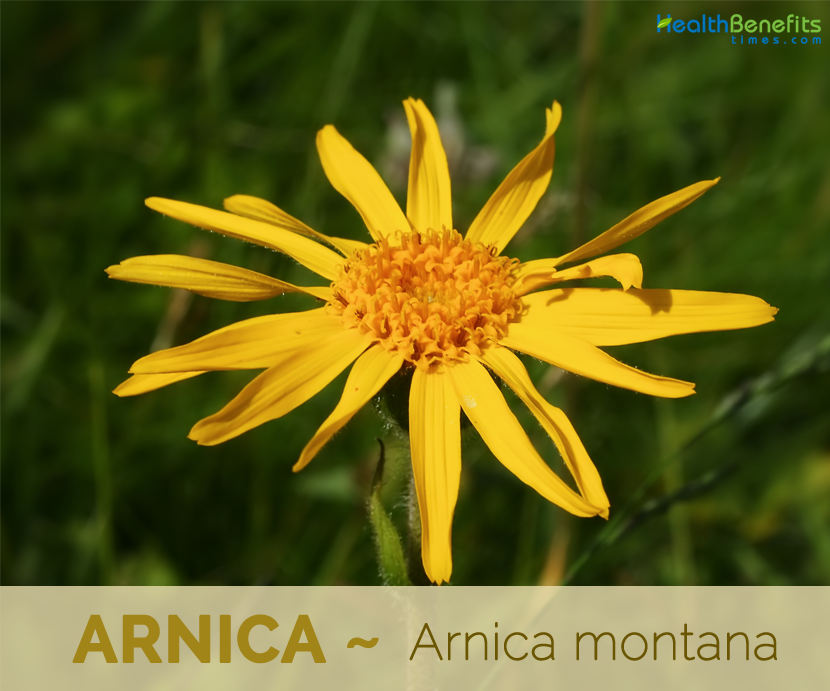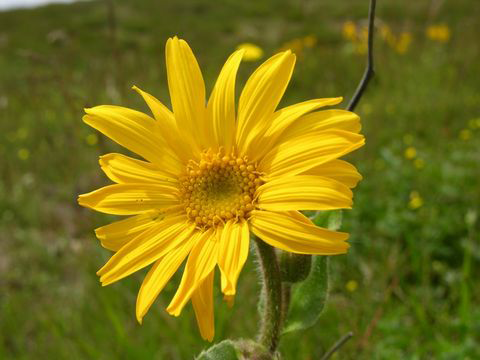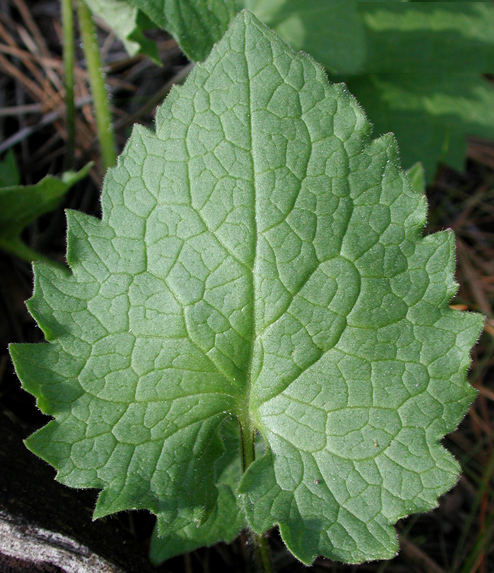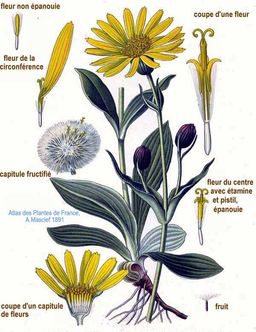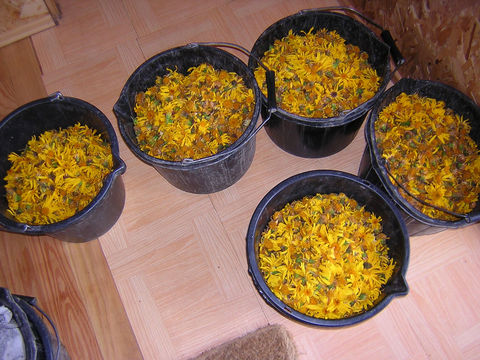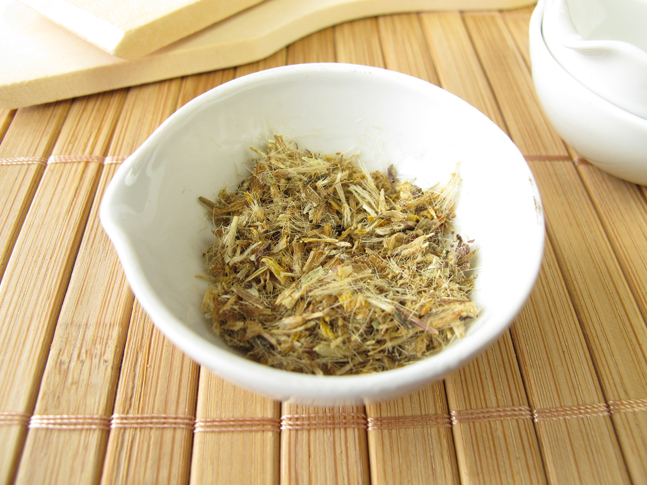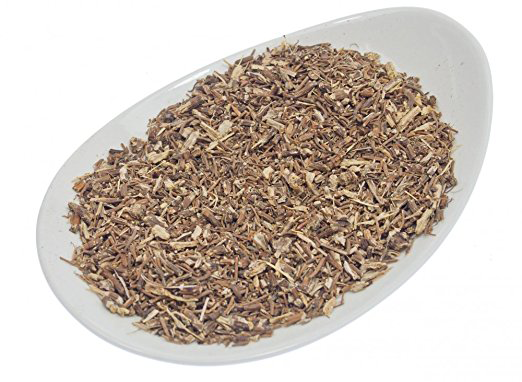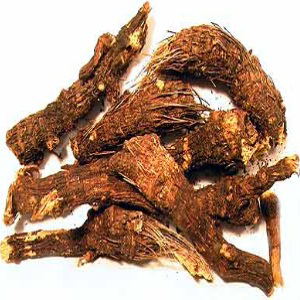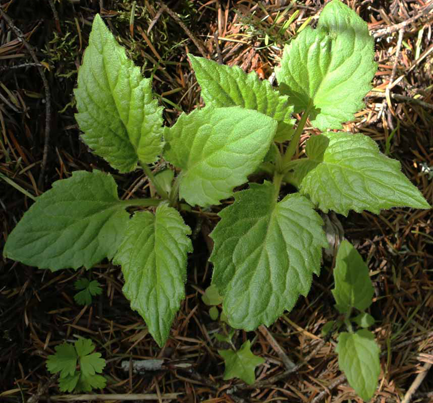Plant Description
Arnica is a perennial, herbaceous plants growing about 0.3 to 0.6 m (1 to 2 feet) tall. The plant is found growing in grassland and shrub land and alpine mountain environments and prefers a moist, well-drained humus rich soil, preferably lime-free. It has dark brown, cylindrical, usually curved rhizomes and slightly hairy, simple or lightly branched stem. Basal leaves are oblong-ovate and short-petioled; upper leaves are smaller and sessile. Later plant produces 1 to 9 large, yellow, daisy-like flower heads, 6–8 cm (2–3 in) wide with 10–15 cm (4–6 in) long ray florets and numerous disc florets. Flower later develops into seed like fruit with white or pale tan bristles. Arnica is toxic when consumed at full strength, but it can be used as an ointment, gel or cream on unbroken skin or taken internally when it is diluted homeopathically. It is applied to the skin for pain and swelling associated with bruises, aches, and sprains. It is also applied to the skin for insect bites, arthritis, muscle and cartilage pain, chapped lips, and acne. Similarly arnica is a flavor ingredient in beverages, frozen dairy desserts, candy, baked goods, gelatins, and puddings.
History
Arnica has a history of folk medicine use in many locations, including North America, Germany, and Russian. The herb has been used in folk remedies since the sixteenth century. A North American indigenous tribe, the Cataulsa, prepared a tea from arnica roots to ease back pains. The German writer Goethe credited arnica with saving his life by bringing down a persistent high fever. Arnica preparations are used extensively in Russia. Folk use there includes external treatment of wounds, black eye, sprains, and contusions. Arnica has been used in Russian folk medicine to treat uterine hemorrhage, myocarditis, arteriosclerosis, angina pectoris, cardiac insufficiency, and in numerous other unproven applications. Nowadays it is grown and used throughout the world.
Health Benefits of Arnica
Arnica montana is one of the most beneficial substances available in nature’s pharmacopeia, with the power to relieve many of the common aches, pains, and injuries that arise in our daily lives. The main uses of Arnica include bruising, swelling, pain relief, arthritis, and injuries. Health benefits of arnica Montana includes:
1. Internal Bleeding
Unique organic compounds within Arnica Montana help to heal broken blood vessels in various layers of the skin, thus eliminating bruising and the unsightly appearance of burst blood vessels and age spots. While research is still being done in terms of which other internal afflictions this herb can help, one thing is sure – if you’ve banged your body somewhere and don’t want to see black and blue in the morning, rub some Arnica montana paste on it! (1)
2. Reduce Inflammation
Arnica is as a soothing agent for inflammation. In case you have sports injuries or strains from exercise, apply some of the Arnica extract or gel directly on the source of the pain, it can work wonders. You can quickly see reduced swelling, due to the organic anti-inflammatory compounds of the plant, and you should soon feel a loosening of the muscles around the affected area. Arnica is one of the most often used herbs by athletes.(2)
3. Moisturize the Skin
Don’t apply pure Arnica extract all over your skin; it can be mixed with carrier oils or other creams to form an effective treatment for dry skin. This moisturizing agent is also important for hair health, as it can considerably protect against dandruff.
4. Postpartum Bleeding
After delivery of a baby, one of the most un-discussed risks to the mother is post-partum bleeding. Tradition and research have shown that using homeopathic Arnica can also help to reduce this bleeding and keep the mother as health and happy as her baby.(3)
5. Analgesic Ability
The anti-inflammatory ability is one side of the coin, but there is also the issue of pain relief. Pharmaceutical like ibuprofen only cover inflammation, often leaving pain present, but Arnica naturally works as an analgesic as well, to relieve topical pain all over the body. However, do not apply Arnica on an open wound, as it does have high-potency compounds that should not be inside the body.(4)
6. Acne and Skin Disorders
Arnica has slight antimicrobial properties, which makes it very beneficial for people suffering from skin conditions, such as acne, psoriasis, eczema, and others. The inflammatory quality, along with the antioxidant activity against whatever is causing the condition makes Arnica montana popular with people who frequently suffer itchy, inflamed skin rashes, which can often be athletes with their gear – yet another reason why athletic individuals are so familiar with the herb.(5)
7. Arthritis Relief
Elderly also get extensive benefits from Arnica supplements. For those suffering from arthritis or other inflammatory conditions that naturally occur as we age, applying some gels or pastes with Arnica montana in them can quickly loosen those aching joints and reduce the swelling so that you can move easier and with less pain.(6)
8. Promote Hair Health
If you find more hair in your comb in your younger years, then you are in the beginning stages of male pattern baldness. If you want to fortify your hair follicles and prevent hair loss, then add Arnica extract to your soaps and shampoos. The rich nutrients bind to the hair and keep it looking younger for longer. In some cases, Arnica can even encourage the growth of new hair, adding to your volume and youth. (7)
9. Wounds and Injuries
Arnica is used for acute and chronic consequences of injury, shock, or surgery, including swelling, bruising, bleeding, and aching pains. The common patient may feel better from lying down or a cold compress; however, the condition worsens from dampness, touch, or at night. Scientific research discovered that homeopathic arnica help to reduce post-operative swelling in 57 patients after surgery involving cruciate ligament reconstruction. Arnica is also used for bone injuries, overexertion, general soreness, muscular strains, ligament tears, and minor injuries.
10. Fevers
Fever is a common sign of a cold or flu. Homeopaths tout arnica as the perfect remedy for fevers, especially when it involves a cold body and hot head. Sufferer’s gas, stools, and sweat will often smell like rotten eggs, and they may not have control of urination or bowel movements. Cold and dampness tend to worsen symptoms; however, symptoms seem to improve from lying down with the head lower than the feet.
11. Tooth and Gum Pain
Gum pain and toothaches that bleed from brushing are actually early signs of gum disease. Homeopathic arnica may be helpful for tooth pain, bruising, bleeding, or sore gums, especially following dental work. Patients may find that movement worsens gum or tooth pain, while lying down will improve the pain.
12. Treatment of Stretch Marks
Topically rubbing arnica extracts reduces the appearance of pregnancy-related stretch marks. All you have to do is gently apply arnica gel on your stomach at least four times a day.
13. Treatment of Bruises and Black Eyes
Arnica is effective in reducing the appearance of bruises. Topical use of arnica extract on bruises and black eyes can significantly improve the condition. Infusions from arnica plant are effective in the treatment of dark nails caused due to injuries from heavy objects.
14. Treatment of Stress and Depression
Arnica is beneficial in alleviating feelings of depression and emotional distress. It is often used in healing sachets to restore emotional balance and a sense of tranquility. Organic and wild grafted arnica flower extract can be massaged to provide warmth which unwinds your taxed and tight muscles and alleviates stress.
Ayurvedic Health benefits of Arnica
- Bruises and sprains: Prepare flower head decoction. Apply it on the affected area. Repeat 2-3 times a day. OR use Arnica gel, oil, cream. Apply on the affected area. In case of Pus, use 4-5 times a day. External use only.
- Internal Injury: Boil some Arnica leaves in water. Drink this water half cup a day for 3 days. OR Buy some Arnica tincture from market. Take 5 drops a day for 3 days. OR Buy Homeopathic medicine Arnica 30 from Ayurvedic store. Take only one dose. This will excrete blood clots through urine.
- Angina: Prepare a tincture from fresh or dried flower heads of Arnica diluted 10 times with water. Drink twice a day.
- Bone Pains: Eat Arnica Capsules. OR Apply Arnica creams on the affected area.
- Hematoma: Take Arnica Montana (30 CH) two tablets two times a day. OR Apply Arnica gel on the affected area. OR Put 2 drops on 4 tbsp of water. Have it two times a day. (Caution: Do not take food and drink for 30 minutes before and after having Arnica)
- Grey Hairs: Use Arnica oil for hair massage.
- Fracture: Have 3-4 tablets of Arnica two times a day.
- Muscle Sprains: Have 2 capsules of Arnica.
- Baldness: Apply Arnica to the scalp twice a day in the form of an ointment or a cream. OR Dilute Arnica with warm water can also be used as a hair rinse.
- Carpal Tunnel Syndrome: Apply Arnica oil to the affected hands. OR Have two Capsules of Arnica two times a day.
- Plantar Fasciitis: Add 1 tbsp of Arnica tincture in warm foot bath water. Soak your feet in it for 15 to 20 minutes Rinse off. Repeat this twice a day 2 to 3 times a week.
- Muscle Cramp: Add 1 tbsp of dried Arnica flower extract in 500 ml water. Soak a cotton cloth in it. Apply the cloth on the affected area. Leave it for 10-12 minutes. Repeat this 2 to 3 times a day to treat Muscle Cramps.
- Muscle Relaxant: Add a handful of dried Arnica leaves in 1 liter warm water. Soak a cotton cloth in it. Dab the cloth on the affected area. Repeat this 2 to 3 times a day to relax the muscles.
- Ganglion: Apply a thin layer of Arnica cream over the affected area. Repeat the process 2 times a day.
- Jet lag: Boil 1 tsp of dried Arnica roots in a cup of water. Simmer for 10 minutes. Strain and drink it twice a day.
- Muscle wasting: Apply the thin layer of Arnica cream over the affected area. Repeat the process 2 times a day.
Traditional uses and benefits of Arnica
- Arnica has a long history of herbal use, especially as an external treatment for bruises and sprains.
- It has been used in the treatment of heart complaints and as a booster for the immune system.
- Arnica increases local blood supply and accelerates healing; it is anti-inflammatory and increases the rate of absorption of internal bleeding.
- If used as a decoction or tincture it encourages the circulation and is valuable in the treatment of angina and a weak or failing heart.
- Whole plant is antiecchymotic, antiphlogistic, nervine, sternutatory, and vulnerary.
- It is especially useful in the treatment of traumatic injuries, sores and bruises.
- Homeopathic dose has been used effectively in the treatment of epilepsy and seasickness, and it might be of use as a hair growth stimulant.
- It is used for fever and colds, inflammation of the skin, cough/bronchitis, inflammation of the mouth and pharynx, rheumatism, common cold, blunt injuries, tendency to infection.
- Arnica and its extracts have been widely used in folk and homeopathic medicine as a treatment for acne, boils, bruises, rashes, sprains, pains, and other wounds.
- Tincture is used for external application to sprains, bruises, and wounds, and as paint for chilblains when the skin is unbroken.
- Few drops of arnica tincture added to warm water in a foot bath will relieve fatigue and soothe sore feet.
- Hair rinse prepared with arnica extract has been used to treat alopecia neurotica, an anxiety condition leading to hair loss.
- Put some arnica on a bug bite to soothe it and to keep the itch away.
Preparations
Arnica is available commercially in the form of liniments and massage oil for external application, and in very dilute homeopathic preparations considered safe for internal use.
Harvest fully open arnica blossoms throughout the flowering season. Pick the flower heads on a sunny day after the morning dew has vanished. Spread the blossoms on a paper-lined tray to dry in a bright and airy room away from direct sun. Temperature in the drying room should be at least 70°F (21.1°C). When the blossoms are totally dry, store it in a dark glass container with an airtight lid. The dried herb will maintain medicinal potency for 12–18 months. Clearly label the container with the name of the herb and the date and place harvested.
1. Tincture
Combine four ounces of fresh or dried arnica flowers with one pint of brandy, gin, or vodka in a glass container. The alcohol should be enough to cover the flowers. The ratio should be close to 50/50 alcohol to water. Stir and cover. Place the mixture in a dark cupboard for three to five weeks. Shake the mixture several times each day. Strain and store in a tightly capped, clearly labeled, dark glass bottle. Tinctures, properly prepared and stored, will retain medicinal potency for two years or more. Arnica tincture should not be ingested without supervision of a qualified herbalist or physician.
2. Arnica Infused oil
Place one cup of dried arnica flowers in a sterilized glass jar. Add 2 cups of olive oil. Shake the bottle gently to mix the herb with the oil, or use a clean spoon to mix them well. Make sure that the flowers are completely immersed in the oil and there’s an inch of free space at the top.
Cover the jar with its lid and place in a sunny spot throughout the day. Bring it inside at night, but repeat the process for a month. You can see the oil taking on the color and smell of the herbs. This is a slow infusion method where sun’s heat is used for the process.
3. Ointment
Simmer one ounce of dried and powdered arnica flowers with one ounce of olive oil for several hours on very low heat. Combine this medicinal oil with melted beeswax to desired consistency. Pour into dark glass jars while still warm. Seal with tightly fitting lids when cool and label appropriately.
4. Infusion
Place two to three teaspoons of chopped, fresh arnica blossoms in a warmed glass container. Bring two cups of fresh, non-chlorinated water to the boiling point, add it to the herbs. Cover. Simmer for about 10 minutes. Strain. The prepared tea will store for about two days in the refrigerator. The infusion may be used to bathe unbroken skin surfaces and to provide relief for rheumatic pain, chill bains, bruises, and sprains. Because of the toxicity of arnica, it is best to avoid internal use without qualified medical supervision.
5. Arnica essential oil
Essential oil of arnica is extracted from the flowers of A. Montana through steam distillation. This highly concentrated preparation should be used with great caution because of its potency. A few drops can be mixed with carrier oil such as almond oil or coconut oil to make healing salves.
Precautions
This herb which provides amazing benefits for your skin, hair, and health, is also associated with several side effects when used excessively. That is why it is important to exercise caution while using it in any form.
1. Stomach Discomfort
Arnica can irritate the digestive system and its lining called mucosa. For this reason, arnica is never taken orally. Even taken in low dosage in homeopathy medicine, it causes irritation in the stomach. This irritation further leads to pain and loss of appetite. But, this problem is temporary and goes away within a day or two.
2. Breast Feeding and Pregnancy
Arnica usage should be avoided if you are pregnant or breast feeding. Arnica is considered as unsafe for pregnant or breast feeding women.
3. Vomiting
As mentioned before, arnica irritates the stomach when taken orally. This irritation may further cause severe nausea or an urge to vomit. This side effect is common among many individuals consuming arnica.
4. Allergy
People sensitive to Compositae or Asteraceae family plants, which includes chrysanthemums, ragweed, marigolds, daisies and related plants, might also be allergic to arnica. People who are hypersensitive to such plants should consult the doctor before using arnica in any form.
5. Nose Bleeding
Arnica can also cause nosebleeds, which is not considered as a serious effect by American Cancer Society. A bleeding nose is not a problem in itself. Rather, it indicates that there is an internal bleeding that needs to be treated. It is best to discontinue the use of arnica on encountering such side effect and immediately visit your doctor.
6. Dizziness
Dizziness occurs as a side effect when arnica is taken for internal issues. When you experience such side effect, consult your doctor immediately.
7. Interactions with Drugs
Arnica may interact with a number of corticosteroids, anesthetic, and anti-inflammatory drugs. It can also cause bleeding when taken with anticoagulants. Specific constituents present in arnica might lower serum lipids in the body. Those taking drugs for lowering cholesterol should take arnica with a caution.
8. Heart Problems
American Cancer Society indicates that arnica might cause irregularities in heart rhythm. This is a condition where the heart beats irregularly. It might either slow down or speed up, causing palpitations. So, consult your doctor immediately if you experience severe palpitations. This is one of the dangerous side effects of arnica since it can cause death. It needs an immediate diagnosis.
9. Tremors
American Cancer Society reports tremor as one of the most common side effects of taking arnica orally. The person might experience uncontrollable movements of legs and hands. Such side effect requires medical evaluation. Tremors signal that your central nervous system has been affected.
10. Other Side Effects
Arnica in undiluted form is considered unsafe. According to a report, it causes faster heartbeat, cardiac arrest, stomach pain, diarrhea, vomiting, skin rashes and shortness of breath. Its toxicity might also cause dyspnea and gastroenteritis. It might also cause damage to your heart, increase the blood pressure level, and organ failure. Sometimes, its consumption leads to coma and even death.
Other Facts
- The leaves have also been smoked as a tobacco.
- Whole plant, harvested when in flower, is used in homeopathic remedies.
- Essential oil has to be diluted before being used externally.
References:
https://www.itis.gov/servlet/SingleRpt/SingleRpt?search_topic=TSN&search_value=505925#null
http://pfaf.org/User/Plant.aspx?LatinName=Arnica+montana
http://davesgarden.com/guides/pf/go/54285/
https://www.mskcc.org/cancer-care/integrative-medicine/herbs/arnica
http://www.floracatalana.net/arnica-montana-l-subsp-montana
https://www.drugs.com/npp/arnica.html
https://medlineplus.gov/druginfo/natural/721.html
http://www.botanical.com/botanical/mgmh/a/arnic058.html
http://www.theplantlist.org/tpl1.1/record/gcc-103364
https://plants.usda.gov/core/profile?symbol=ARMO8
http://www.encyclopedia.com/plants-and-animals/plants/plants/arnica
https://en.wikipedia.org/wiki/Arnica
http://www.herbsrainbear.com/encylopedia/arnica.htm
http://www.ndhealthfacts.org/wiki/Homeopathic_Arnica
Comments
| Arnica Quick Facts | |
|---|---|
| Name: | Arnica |
| Scientific Name: | Arnica montana |
| Origin | Mountainous regions of Europe and southern Russia |
| Shapes | Seed like fruit with white or pale tan bristles |
| Taste | Sweet |
| Health benefits | Reduce Inflammation and Arthritis Relief |
| Name | Arnica |
|---|---|
| Scientific Name | Arnica montana |
| Native | Mountainous regions of Europe and southern Russia |
| Common Names | Mountain tobacco, Leopard’s bane, Wolf’s bane, Mountain arnica, Leafy Arnica, European Arnica, Mountain Snuff, Sneezewort, Smoke herb, Thunder wort, Wound herb |
| Name in Other Languages | Afrikaans: Arnika Albanian: Arnica Arabic: زهرة العطاس Armenian: Arnica Azerbaijani: Arnika Basque : Arnica Belarusian: Арніка Bengali: Bhēṣajabr̥kṣabiśaṣa (ভেষজবৃক্ষবিশষ) Bosnian: Arnika Bulgarian: Aрника Catalan : Arnica Cebuano: Arnica Chichewa: Arnica Croatian: Arnika Czech: Arnica Chinese: Shan jin Che (山金车) Danish: Arnica Dutch: Arnica Estonian: Arnika English: European Arnica, mountain arnica Esperanto: Arniko Filipino: Arnica Finnish: Etelänarnikki, arnica French: Arnica des montagnes, Arnica des montagnes, Herbe aux prêcheurs, arnica Galician: Arnica German: Arnika Greek: Farmakeftikó fytó (φαρμακευτικό φυτό) Georgian: Arnica Gujarati: Pahāḍī tamākunā chōḍanō prakāra (પહાડી તમાકુના છોડનો પ્રકાર) Haitian Creole: Arnika Hausa: Arnica Hebrew: ארניקה Hindi: Arnika (अर्निका) Hmong: Arnica Hungarian: Arnika Icelandic: Arnica Igbo: Arnica Irish: Arnica Italian: Arnica Indonesian: Arnica Javanese: Arnica Japanese: Arunika (アルニカ) Kannada: ಆರ್ನಿಕ Kazakh: Арника Khmer: Arnica Korean: Aleunika (아르니카) Lao: Arnica Latin: Arnica Latvian: Arnikas Lithuanian: Arnikos Macedonian: Aрника Malagasy: Arnica Maltese: Arnica Malayalam: Arnica Maori: Arnica Marathi: Arnica Mongolian: Arnica Myanmar (Burmese): Arnica Nepali: Arnica Norwegian: Arnica Persian: Arnica Polish: Kupalnik Portuguese: Arnica Romanian: Arnică Russian: Arnika gornaja, barannik, арника горная, баранник Sesotho: Arnica Serbian : Aрника Sinhala: Arnica Slovak: Arnika Slovenian: Arnica Somali: Arnica Spanish: Arnica Swahili: Arnica Swedish: Hästfibla, slåttergubbe, Arnica Tajik: Arnica Tamil: Arnica Telugu: Sugandhaṁ (సుగంధం) Thai: Arnica Turkish: Arnika Ukrainian: Aрніка Urdu: جب Arnica Uzbek: Arnika Vietnamese: Giống cây cúc Welsh: Arnica Yiddish: אַרניקאַ Yoruba: Arnica Zulu: Arnica |
| Plant Growth Habit | Perennial, herbaceous plants |
| Growing Climate | Found in grassland and shrub land and alpine mountain environments |
| Soil | Prefers a moist, well-drained humus rich soil, preferably lime-free |
| Plant Size | 0.3 to 0.6 m (1 to 2 feet) |
| Rhizome | Dark brown, cylindrical, usually curved |
| Stem | Slightly hairy, simple or lightly branched stem |
| Leaf | Basal leaves are oblong-ovate and short-petioled; upper leaves are smaller and sessile. |
| Flowering Periods | June to August |
| Flower | 1 to 9 large, yellow, daisy-like flower heads, 6–8 cm (2–3 in) wide with 10–15 cm (4–6 in) long ray florets and numerous disc florets. |
| Fruit | Seed like fruit with white or pale tan bristles. |
| Flavor/Aroma | Strong and distinct pine-sage odor |
| Taste | Sweet |
| Plant Parts Used | Root, flowers, rhizome |
| Available Forms | Gels, tablets, tinctures, ointments and mouth rinses |
| Health benefits |
|


